Gouegoui Serge-Pacôme Bohui1, Clément Djedjro Akmel2, Mabintou Kalo2, Florence Bobelé Niamke2, Jean David N'guessan3, Augustin Amissa Adima2, Barthélémy Attioua1
1Department of Physics Chemistry, Felix Houphouet-Boigny University, Abidjan, Ivory Coast
2Department of Agro-Food Chemical Engineering, National Polytechnic Institute Felix Houphouet-Boigny, Yamoussoukro, Ivory Coast
3Department of Biochemistry and Pharmacodynamics Pharmacodynamie Biochimique, Felix Houphouët-Boigny University, Abidjan, Ivory Coast
Correspondence to: Gouegoui Serge-Pacôme Bohui, Department of Physics Chemistry, Felix Houphouet-Boigny University, Abidjan, Ivory Coast.
| Email: |  |
Copyright © 2024 The Author(s). Published by Scientific & Academic Publishing.
This work is licensed under the Creative Commons Attribution International License (CC BY).
http://creativecommons.org/licenses/by/4.0/

Abstract
The extraction of total flavonoids from combinations of Azadirachta indica, Cymbopogon citratus and Psidium guajava leaves was optimized according to a mixed experiment design. Fifty-four experiments conducted with 3 repetitions for each, were carried out after an appropriate choice of 3 interpretable variables, which lead to a mathematical 1st degree polynomial model. After analysis of the effects, this model shows that the most important factor is the ratio (p-value<0.0001), the second is the extraction mode (p-value<0.05); the third factor, corresponding to the extraction time, has a negligible effect on the response (p-value>0.05). Interactions between factors are also negligible. The combination of leaves of the three plants in the proportions of 10% Azadirachta indica, 20% Cymbopogon citratus and 70% Psidium guajava by decoction allows to extract the highest content of total flavonoids with an average of 2,067 mg.EG/mL. The results indicate possible biological properties of this extract which suggest the investigation of the antiplasmodial activity and the ability to consummation of this extract as part of the fight against malaria.
Keywords:
Azadirachta indica, Cymbopogon citratus, Psidium guajava, Flavonoids, Mixed factorial design, Malaria
Cite this paper: Gouegoui Serge-Pacôme Bohui, Clément Djedjro Akmel, Mabintou Kalo, Florence Bobelé Niamke, Jean David N'guessan, Augustin Amissa Adima, Barthélémy Attioua, Optimisation of Total Flavonoid Extraction from Combinations of Azadirachta Indica, Cymbopogon Citratus and Psidium Guajava Leaves Using a Mixed Factorial Design, American Journal of Chemistry, Vol. 14 No. 2, 2024, pp. 27-33. doi: 10.5923/j.chemistry.20241402.02.
1. Introduction
Traditional medicine has long been a source of cultural heritage in Africa to which the population has remained attached in terms of primary health care [1]. According to the WHO, 80% of the African population uses traditional medicine for their health needs [1]. In addition, studies conducted in Côte d'Ivoire have reported that more than 90% of the population uses traditional medicine to treat many diseases. These works have also shown that several plants of the Ivorian flora have active ingredients with antiplasmodial activity, namely tannins, flavonoids, polyphenols, triterpenes, sesquiterpenes, quinones, alkaloids [2]. These secondary metabolites are responsible of the biological activity of several plant-based recipes known for their virtues in the management of malaria. In Mali, Azadirachta indica leaf decoction is taken orally and in body baths to treat malaria [3]. In Burkina Faso, Psidium guajava leaves are used to treat malaria and jaundice [4]. In Côte d’Ivoire, the infusion or decoction of Cymbopogon citratus leaves alone or combined with Cassia occidentalis and Aurantifolia is used in the case of malaria, especially during pregnancy [5]. Also, health practitioners of traditional Ivorian medicine, offer different plants and also various combinations based on these plants to treat diseases such as high blood pressure and malaria [6]. It is within this framework that we became interested in "Ahoutou", a local recipe based on the leaves of 3 plants, Azadirachta indica, Cymbopogon citratus and Psidium guajava used successfully in the management of malaria in Côte d'Ivoire [7].The therapeutic properties of medicinal plants are attributed to the presence of many secondary metabolites, including polyphenols [8]. They are one of the main classes of secondary plant metabolites. The latter consist of 3 major families, including alkaloids, terpenoids and polyphenols [9]. In traditional Ivorian medicine, aqueous plant extracts are prepared without taking into account certain important extraction parameters (ratio, nature of the solvent, duration, etc.). However, it is known that the extraction of biomolecules such as polyphenols whose flavonoids are influenced by various parameters such as temperature, extraction time, plant material ratio, nature of the solvent and the extraction method [10]. Several extraction methods are then used. However, it is important to define the optimal extraction conditions through the use of the experimental design, a tool commonly used in experimentation [11].The experimental designs are used to identify the optimal conditions for the extraction of these compounds in order to propose them to the followers of this unconventional medicine. Experimental designs make it possible, without loss of information, to reduce the number of tests to be carried out, to determine the most influential extraction parameters and to propose the best extraction conditions [12]. This method is an indispensable statistical tool to conduct the experiment in an optimal way. It is also used in many fields (industry, research) to improve process performance and control product quality [11]. This work is part of the valorization of traditional medicine drugs with the aim of dosing the total flavonoids of the Ahoutou recipe and to propose a mathematical model to optimize the extraction of total flavonoids from these three plants thanks to a mixed factorial plan.
2. Equipment Material and Methods
2.1. Experimental Product and Plant Material
2.1.1. Experimental Product
The experimental product studied, called "Ahoutou", is a local recipe from "Djahakro", a village in the commune of Yamoussoukro, prepared by a traditional therapist called Ahoutou Séraphin. The recipe is a decoction of a mixture of leaves from three plants: Azadirachta indica, Cymbopogon citratus and Psidium guajava, obtained after boiling for 45 minutes. It is a fluid solution with a brown colour and a bitter taste. For this study, three samples of this recipe obtained on different days were assayed for total flavonoid content.
2.1.2. Plant Material
The plant material also consists of the leaves of three plants of Azadirachta indica, Cymbopogon citratus and Psidium guajava. The leaves were harvested in Yamoussoukro (Côte d'Ivoire) and dried in the shade for ten (10) days. After drying, the leaves were ground and powdered.
2.2. Extraction
The extracts obtained from powders have been prepared according to the classic methods of preparing extracts used in village settings, namely infusion, decoction and maceration. This allowed aqueous extracts to be obtained.
2.2.1. Infusion
A test portion of 1 g of powder mixture of Azadirachta indica (A), Cymbopogon citratus (C) and Psidium guajava (P) in the permutations of 10%, 20% and 70% proportions was introduced into 100 mL of boiling distilled water. The assembly is maintained until cooling down at variable times of 5 min, 30 min and 45 min. After filtration, the aqueous extracts obtained were determined.
2.2.2. Maceration
A test portion of 1g of powder mixture of Azadirachta indica (A), Cymbopogon citratus (C) and Psidium guajava (P) in the permutations the proportions 10%, 20% and 70% was introduced into 100 mL of distilled water. The assembly was kept under magnetic agitation for variable times, from 5 min, 30 min and 45 min in cold conditions. After filtration, the aqueous extracts obtained were determined.
2.2.3. Decoction
A test portion of 1 g of powder mixture of Azadirachta indica (A), Cymbopogon citratus (C) and Psidium guajava (P) in the permutations 10%, 20% and 70% proportions was introduced into 100 mL of distilled water. The whole was kept boiling at variable times (5 min, 30 min and 45 min). After filtration, the aqueous extract obtained was kept in a beaker for assaying.
2.3. Spectrophotometric Determination of Total Flavonoids
The method of Marinova et al [13] was used for the determination of total flavonoids. In a 25 mL vial, 0.75 mL of 5% (w/v) sodium nitrite (NaNO2) was added to 2.5 mL of aqueous extract. 0.75 mL of 10% (w/v) aluminum chloride (AlCl3) was added to the mixture and incubated for 6 minutes in the dark. After incubation, 5 mL sodium hydroxide solution (NaOH, 1 N) was added and the volume was made up to 25 mL with distilled water. The mixture was stirred vigorously before being assayed with the Jasco V-530 spectrophotometer (JASCO, Japan). The reading was taken at 510 nm. The tests were carried out in triplicate. The flavonoid content was expressed in milligrams per litre of quercetin-equivalent extract (mg EQ /mL). The total flavonoid content of the three preparations (Nos 1, 2 and 3) of the Ahoutou recipe was determined by the abovementioned method.
2.4. Optimization of Extraction Conditions with the Help of Designs of Experiments
2.4.1. Study Parameters
This work consists of determining a mathematical model of the total flavonoid extraction rate from the combination of three plants that make up the Ahoutou recipe. The parameters listed that may influence the diffusion of total flavonoids are: extraction process, ratio, plant size, extraction time and nature of the solution [10]. In order to mimic the development of the "Ahoutou" recipe that uses water and leaves, three variables were taken into account in our study. It's about: • Time: X1, the extraction time of total flavonoids (5 min, 30 min and 45 min)• The Ratio: X2, the different permutations of the proportions of the three plants during mixing (10%, 20% and 70%). • Extraction process: X3, the different classical extraction processes (Infusion, Decoction and Maceration) These three factors have the advantage of being easily controllable even on a small scale.
2.4.2. Mathematical Processing
The rate of extraction of total flavonoids (y= Total flavonoids extracted in 1 g of mixture of leaves of the three plants in the proportions of 10%, 20% and 70%) depends on the main factors X1, X2 and X3, mathematically translated by: y = Y + Ɛ, with Y a 1st degree model expressed by Y= f(X1, X2, X3)= a0 + a1X1+ a2X2 + a3X3+ a12X1X2+ a13X1X3+ a23X2X3 + a123X1X2X3, which is the theoretical content of total flavonoids extracted en 1 g of leaf mixture and Ɛ an explanation error term. Also, we have: - a0, the constant coefficient - ai, the coefficients of the main factors Xi - aij, the coefficients of the interaction factors XiXj The coefficients of the Y model were determined by linear regression using Microsoft Excel's analysis utility. The experimental study will therefore consist of highlighting the effects of factors on response. The multi-level factorial design seems to be suitable for solving this type of problem, especially the mixed factorial design. The extraction of total flavonoids from the combination of the 3 plants studied, during the preparation of extracts by infusion, maceration and decoction, made it possible to set the low and high levels of three technological parameters studied (the extraction process, the ratio and the extraction time) as shown in Table 1. For the ratio, the different permutations of the proportions (10%, 20% and 70%) of the three plants make it possible to achieve six (6) possible mixtures or ratios. In this work, it was assumed that the formula 10% A+20% C+70%P is the lowest ratio and 70% A + 20% C + 10% P is the highest ratio. Thus, the different codes assigned to the main factors are shown in Table 2.Table 1. Main factors and their areas of variation
 |
| |
|
Table 2. Technology parameter codes
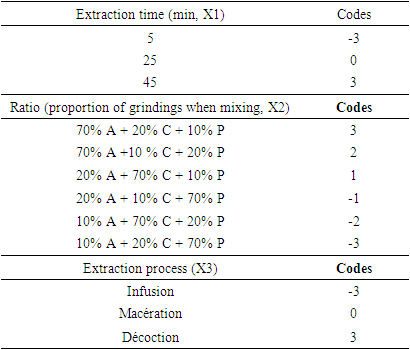 |
| |
|
2.4.3. Characteristics of the Experimental Design
We chose a mixed factorial design. This plan requires 3x6x3 tests, i.e. 54 tests for the factors. These trials were conducted in triplicate and the mean value of the total flavonoid extraction rate was taken as the response (y) for the trial under consideration. The characteristics of the plan are grouped in Table 3 and the experience matrix is shown in Table 4.Table 3. Plan Characteristics
 |
| |
|
Table 4. Experience Matrix
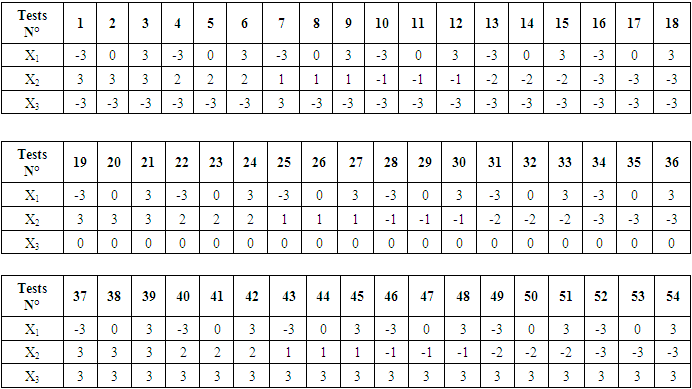 |
| |
|
3. Results
3.1. Flavonoids Content
The flavonoid content of the extracts was obtained from a calibration curve using quercetin as the standard (Figure 1). It is expressed in mg quercetin equivalent / mL extract. 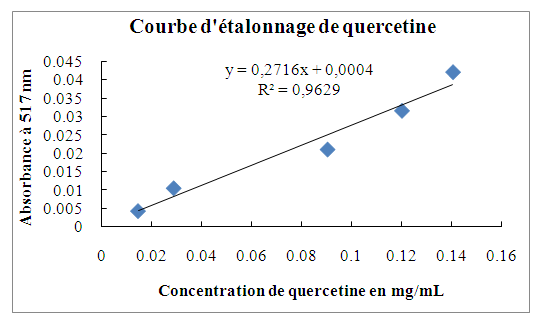 | Figure 1. Quercetin calibration curve |
The results of the determination of the flavonoid content of three different preparations of the "Ahoutou" recipe and the different permutations of mixtures (54 trials of the experimental design) are shown in Table 5 and Table 6 respectively.Table 5. Flavonoid content of three Ahoutou preparations
 |
| |
|
Table 6. Experimental design test results
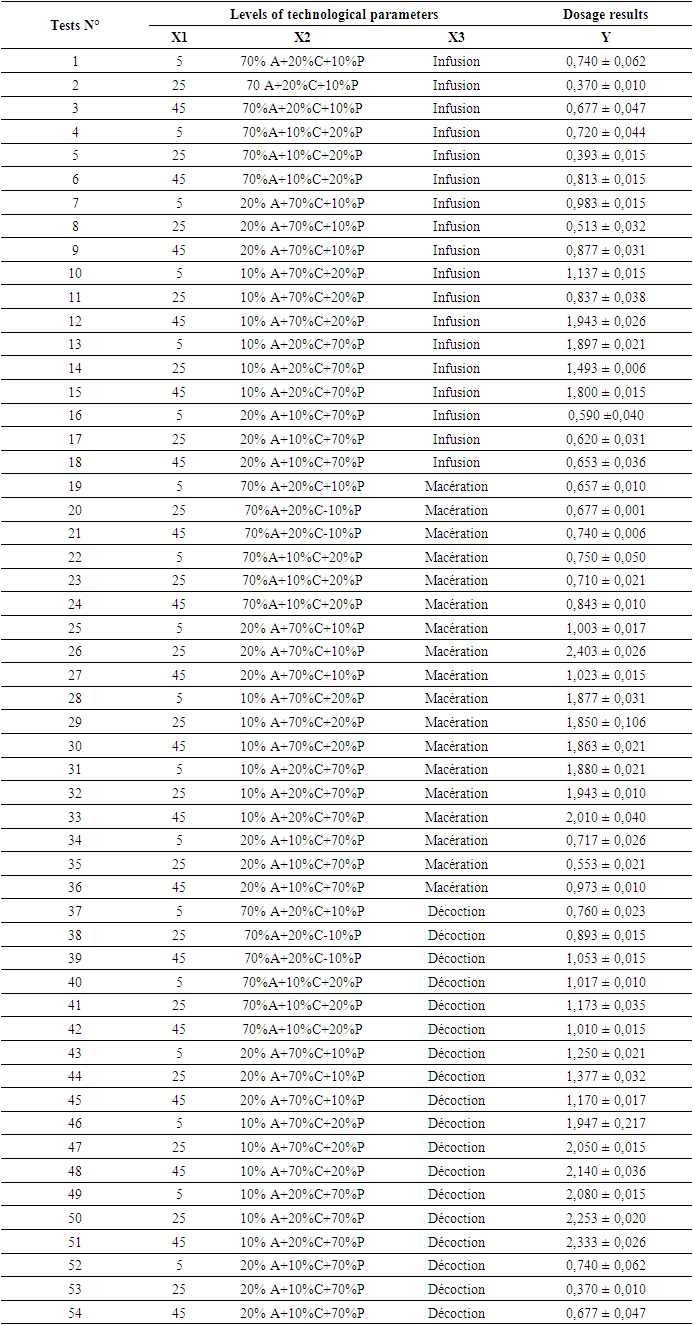 |
| |
|
The total flavonoid content of the Ahoutou recipe varies according to the preparations indicating that not all the parameters of Ahoutou preparation are under the control of the traditherapist. This result is consistent with that observed by Stalikas [6]. Indeed, according to the latter, the aqueous extracts of Ivorian plants are prepared by ignoring certain important extraction parameters such as ratio, duration, etc.However, the extraction of biomolecules such as polyphenols and, specifically, flavonoids, is influenced by these parameters, the ignorance of which can lead to their alteration.There is variability in the flavonoid content between 0.393 and 2.403 mg EQ/mL). The mean flavonoid value recorded is 1.182 ± 0.597 mg EQ/mL.
3.2. Analysis of Precision and Variance of the Regression Model
The flavonoid regression model (Table 7) yielded a coefficient of determination (R²=0.6381), indicating that the regression explains 63.81% of the variability observed in the preparation of flavonoid extraction. The coefficient of determination adjusted to Ra² = 0.583 confirmed that the model was significant. Also the regression yielded a p-value of less than 0.0001 (p-value<0.0001), again demonstrating the high significance of the regression model.Table 7. Analysis of variance of the response "Total flavonoid levels"
 |
| |
|
3.3. Analysis of Regression Model Coefficients and Estimation of Flavonoid Content
Analysis of the coefficients (Table 8) based on the corresponding p-values (<0.05) shows that the significant coefficients are a0, a2 and a3. This indicates that Y = a0 + a2X2 + a3X3. The extraction of flavonoids is there fore influenced by the extraction process (X2) and the ratio (X3). By replacing the different coefficients by their respective values, we obtain the following mathematical model: Y = 1.2283 - 0.2061 X2 + 0.0487 X3.As for the time factor (X1), it has an unappreciable effect in the chosen range of variation, i.e. between 5 and 45 min. Table 8. Effects of the "Total Flavonoid Rate" Response Model
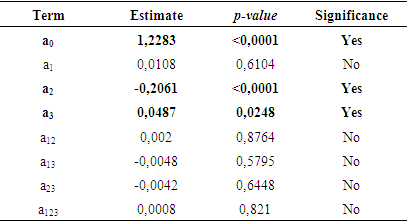 |
| |
|
3.4. Optimization of the Flavonoid Content in the Preparation of Ahoutou
The optimization of the responses in this study corresponds to maximizing the levels of total flavonoids contained in the extract derived from the combination of the leaves of the three plants. The Excel solver program was used to determine the theoretical optimal levels of factors for maximizing flavonoid content. Thus, in order to best extract the total flavonoids, the extraction (X3) should be done by aqueous decoction of the grind for a ratio (X2) of 10% Azadirachta indica + 20% Cymbopogon citratus and 70% Psidium guajava for a maximum content of 2.067 mg EQ/mL.
3.5. Validation by Experience of the Choice Indicated by the Mixed Factorial Design
For model validation, 3 trials were conducted to prepare Ahoutou while maintaining the optimal levels of ratio X3 to (3) and the extraction process X2 to (3). The mean value of the total flavonoid content was yexp (Table 9). Furthermore, the Relative Deviation Error (RDE) obtained is 0.9% which is well below 10%. Table 9. Experimental and Predicted Value for the Test Point
 |
| |
|
The experimentally obtained amounts of total flavonoids (2.047 ± 0.014 mg. EQ /mL) are greater than that predicted by the mathematical model (2.027 mg. EQ /mL). However, there is no significant difference (Student's test with p>0.05) between the experimental and predicted results of the investigational compound. The mixed factorial design (design with variable factor levels) is valid for predicting the amount of flavonoids in the chosen experimental field [14].
4. Discussion
In view of the results obtained, several factors can influence the extraction yield of total flavonoids, among them the extraction method. The comparison between the classical extraction methods (infusion, maceration and decoction) showed that decoction was the best to extract the maximum of flavonoids [7]. In the search for an efficient optimization of flavonoid extraction from various sources, the choice of the ratio including the best proportion of each plant in the mixtures plays a very important role in the extraction of total flavonoids. Using the experimental design, several extraction yields of total flavonoids were determined for mixtures of the three plants taken in proportions of 10%, 20% and 70%. Thus, the proportions of mixtures of 10% Azadirachta indica, 20% Cymbopogon citratus and 70% Psidium guajava enabled us to extract flavonoids better in preparations with a more interesting flavonoid extraction rate. This result is better than the Ahoutou recipe concocted by the traditional practitioner. The total flavonoid content of the Ahoutou recipe was low. This could be due to the lack of control of the proportions of each plant in the preparation mixes. According to KOFFI et al [10], the ratio can influence the yield of total flavonoids. Regarding extraction time, this factor does not have a significant effect on the extraction of total flavonoids. According to the literature, the extraction of phenolic compounds, especially flavonoids, at high temperatures (above 80°C) would affect the stability of the compounds due to chemical and enzymatic degradation and/or losses by thermal decomposition [15]. At this stage, the extraction time becomes important, as longer extraction periods can lead to greater losses of flavonoids. Optimization of the extraction time factor suggests that extraction could be extended until maximum flavonoid yield is reached [15].
5. Conclusions
The aim of this study is to measure secondary metabolites of an "Ahoutou" recipe used in the traditional treatment of malaria in Cote d’Ivoire. Thus, a process for extracting the secondary metabolites, in particular the flavonoids contained in the extracts derived from the combination of three plants Azadirachta indica, Cymbopogon citratus and Psidium guajava was proposed. This work was carried out using an experimental design that allowed us to obtain a model for obtaining total flavonoid levels. We have successfully achieved a high extraction yield of total flavonoids compared to the traditional practitioner's recipe. The experimental design proves very useful in practice and allows us to appreciate an optimum adjustment of the parameters of the extraction process of the flavonoid levels contained in the combination of three plants. The results showed that the recovery of flavonoids in herbal combination recipes was affected by the method of extraction and the different proportions (ratio) of these plants. Extraction time had no significant effect on their yield. In perspective, with the results obtained, this extract could present interesting biological properties to evaluate antiplasmodial activity and food safety in the fight against malaria.
References
| [1] | K.K. Ajibesin, B.A. Ekpo, D.N. Bala, E.E. Essien, S.A. Adesanya, Ethnobotanical survey of Akwa Ibom State of Nigeria, Journal of Ethnopharmacology, 115 (2008) 387-408. |
| [2] | K. Tuo, Phytochemical, antioxidant and antiplasmodial activity in vitro of five plants traditionally used in Côte d'Ivoire against malaria, Félix Houphouët Boigny University, Abidjan-Cocody, 2015, pp. 200. |
| [3] | D. Sangaré, Study on the management of malaria by traditional healers in the health zones of Kendie (Bandiagara) and Finkolo (Sikasso), doctoral thesis. Bamako, (2003) 58. |
| [4] | Mr A. A. Maïga, Study on the chemistry and biological activities of six (6) plants used in the traditional treatment of diabetes: Allium cepa; Allium sativum; Daucus carota; Eucalyptus globulus; Psidium guajava and Solanum melongena, University of Bamako, Bamako, 2014, p. 135. |
| [5] | H. Die-Kacou, M. Kamagate, J.C. Yavo, Plant poisoning in Abidjan: difficulties of etiological diagnosis and ethnobotanical aspects, Bio-Africa Review, 7(2009) 34-43. |
| [6] | T. V. Dougnon, E. Attakpa, H. Bankolé, Y. M. G. Hounmanou, R. Dehou, J. Agbankpè, L. Baba-Mouissa, Ethnobotanical Study of Medicinal Plants Used Against a Contagious Skin Disease: Human Scabies in South Benin, Pharmacopoeia and African Traditional Medicine, 18 (2017) 16-22. |
| [7] | P.S.G. Bohui, A.A. Adima, F.B. Niamké, J.D. N'Guessan, Comparative study of three methods of extraction of total flavonoids from the leaves of medicinal plants: Azadirachta indica and Psidium guajava, Journal of the West African Society of Chemistry, 046 : (2018) 50 -58. |
| [8] | N. M. Kouame, M. Kamagate, C. Koffi, H. M. Die-Kakou, N. A. R. Yao, A. Kakou, Cymbopogon citratus (DC.) Stapf: ethnopharmacology, phytochemical, pharmacological activities and toxicology. Phytothérapie, 14 (2016) 384-392. |
| [9] | A. M. Mannino, C. Micheli, Ecological function of phenolic compounds from Mediterranean fucoid algae and seagrasses: An overview on the genus Cystoseira sensu lato and Posidonia oceanica (L.) Delile. Journal of Marine Science and Engineering, 8(1) 19. |
| [10] | N.E. Koffi, Contribution to the optimization and chemical study of polyphenols of two plants from Ivory Coast Tectona grandis Linn (Verbenaceae) and Justicia secunda Vahl (Acanthaceae), Nangui Abrogoua University, (2014) 160. |
| [11] | L. Karboua, M. Bekhiti, R. Zaitri, Optimizing the mechanical behavior of clay using cement and PVC aggregates with the application of a mixture design method, Construction and Building Materials, 405 (2023) 133-343. |
| [12] | S. VIVIER, Stéphane. Optimization Strategies by the Design of Experiments Method, and Application to Finite Element Modeled Electrotechnical Devices, Ph.D. Thesis, University of Science and Technology of Lille-Lille I, 2002. |
| [13] | D. Marinova, F. Ribarova, M. Atanassova, Total phenolics in bulgarian Fruits and vegetables, Journal of the University of Chemical Technology and Metallurgy, 40 (2005) 255-260. |
| [14] | S.R. Rao, G. Padmanabhan, Linear modeling of the electrochemical machining process using full factorial design of experiments, Journal of Advanced Mechanical Engineering, 1 (2013) 13-23. |
| [15] | E. Kiassos, S. Mylonaki, D.P. Makris, P. Kefalas, Implementation of response surface methodology to optimise extraction of onion (Allium cepa) solid waste phenolics, Innovative Food Science and Emerging Technologies, 10 (2009) 246-252. |




 Abstract
Abstract Reference
Reference Full-Text PDF
Full-Text PDF Full-text HTML
Full-text HTML







